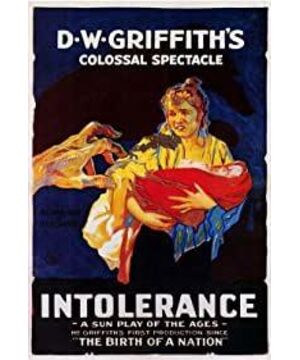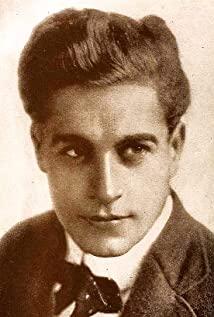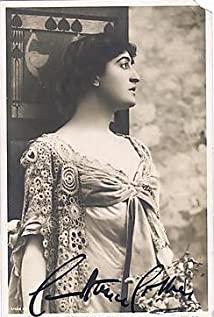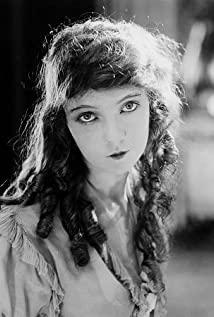Speaking of Griffiths, the most famous work is actually the groundbreaking, politically correct, and notorious The Birth of a Nation, which was filmed before "Party Dissent." In that movie, the American people originally lived and worked in peace and contentment, and did not want the Civil War to break out. In the end, the South was defeated, and the blacks took over, and even became the leading political force and began to oppress the whites. In fact, even today the United States has elected a black president, and the blacks are Political influence is still limited. Therefore, "The Birth of a Nation" can be regarded as a sci-fi film. There is a section in the film that impressed me deeply. The northern army killed like the southern army. A group of black people burned, killed and looted. It was extremely brutal. Although the soldiers behaved brutally on the battlefield The scene of the film will not surprise me, but the film's deliberate emphasis on skin color does show some of Griffith's positions. Of course, the film is still very successful, the narrative is smooth, the whole story has an epic feel, and the details, such as Lincoln's assassination, show superb skills, and with these basic elements as the foundation, the incitement of the film is also It's very strong. Watching the white family being tortured by black tyranny in the film makes the subsequent actions of the KKK seem logical. Therefore, although the film caused great controversy at the time, it still sold well.
After "The Birth of a Nation", Griffith did not stop, invested heavily, and made a more ambitious "Party Dissent", which turned from the violent confrontation of the previous one. He talked about the A story of love and tolerance. The film first adopts a four-stage multi-clue story, which is advanced with four stories: the fall of Babylon, the crucifixion of Jesus, the massacre of St. Bartholomew in France, the modern American labor conflict and justice. And this method of segmented multi-clue narrative has been widely used in today's movies, including many classic movies. Secondly, as mentioned above, the four stories in this film are not in a certain time and space, but they all focus on a theme, and at the same time have their own care and connection with each other. It is this narrative that spans time and space that can better express the grandeur and universality of the theme , more dramatic. And movies like "All the time" have also successfully applied similar techniques. Third, there are four stories in this film, including the grand war scenes of the Babylonian and Persian wars, the emotional impact of the French religious slaughter, and the turbulent fate and ups and downs of emotional life of a modern little cutie. It can be said that a film The film covers a variety of film themes and genres, large and small. Griffith is sometimes rough, sometimes delicate, and it can be said that he plays with the art of film in the palm of his hand.
Although the four stories have different ages and backgrounds, they connect and echo each other smoothly, and the themes are related to the relationship between love and tolerance or intolerance revealed at the beginning of the film. In Babylon, facing the Persians, the king led the people to fight back and repel the enemy, but he did not want to have a "Trojan horse" in his kingdom. The priests who held a grudge against him opened the gates of the city and let Babylon fall. In this story, there is a "girl in the mountains". She is pungent but kind and brave. She has a faint affection for the king. This love makes her not afraid of danger and fights with all her strength to save Babylon. In France, the prejudice between sects and the cruelty of some rights-loving people eventually led to a religious massacre. This story, which focuses on the tragic destruction of a family, makes us deeply feel the tragedy of civilians brought about by intolerance. The crucifixion is a weak line in the film, but we are all familiar with the story of Jesus, and Griffith only needs to show the scene of Jesus carrying the cross and walking through the crowd to set off the theme of the film. And the strongest clue of this film is still in modern times, a group of sanctimonious upper class ladies launched the so-called reform movement, such as prohibiting alcohol, banning social activities of workers, etc., while at the other end, a carefree "cute" Enjoying the sunshine of life. At that time, when the relationship between capital and labor was tense, the capitalists’ tough implementation of policies eventually led to street fires. “Little Cutie”’s father died tragically. When he decided to quit the gang, the young man was framed by the unwilling gang leader and imprisoned again, and then "Little Cutie" faced his own child being taken away by the "reformists", and finally waited for his lover to be released from prison. In an accident, The lad was framed again and faced hanging. Compared with the other three historical stories, the story of "Little Cutie" is more universal, more close to the people, and more easily moved by ordinary people. From the life history of a girl in an intolerant environment, we can see what an ordinary person suffers. Destruction is the most concentrated display of the theme.
In addition to the perfect fit between the theme and various branches, the details of this film are even more commendable. In each story switch, Griffith introduces the "cradle" scene, a mother constantly shaking the cradle, and the history of human intolerance also begins from the infancy of human birth. The cradle scene is metaphorical, the mother There is a deep sense of fate in the swaying calm movement. And Griffith is even more skillful in playing with the camera. One of the most impressive scenes in the film is that "Little Cutie" and everyone chased the speeding train in the car, trying to catch up with the mayor's request for amnesty for his lover; Meanwhile, "Girls of the Mountains" galloped from the Persian camp to Babylon in a carriage, trying to warn the king; in France, it was men who rode home trying to save families at risk from the Holocaust. Cars, trains, carriages, horses, high-speed scenes in different time and space are alternately switched at high speed, and people's anxious expressions give people a strong sense of urgency and impact, which makes me high-five and admire.
Although Griffith showed all the tragedies brought about by intolerance, he still hopes to tell people that tolerance can bring peace of life and long-term peace. Therefore, in the story of "Little Cutie", in the end, with the help of a group of people, "Little Cutie" arrived in time to save her husband when the lover's neck was tied with a noose, and the two finally embraced, We have started a happy life again, which seems to reveal that no matter what history has been, starting from today, as long as we help others with tolerance and kindness, all kinds of tragedies can be avoided in the end, and past losses can be slowly made up. In the fall of Babylon, beside the "girl in the mountains" who was shot to death by random arrows, Griffith also released two white doves, so that her death revealed a kind of holiness, the girl tried with love to prevent the more common The war brought by intolerance in people's hearts, its tragic and solemn finally permeates a poignant death scene, which makes people respect.
Because of a controversial "Birth of a Nation", Griffith made his career with its huge box office. However, this "Party to Fight Differing", which is better in terms of theme, narrative and technique, failed miserably at the box office that year, giving Griffith a heavy blow. In fact, looking at it now, you can imagine that even today, there are several commercial blockbusters that dare to play with multiple clues narratives, but also interlace time and space, and engage in such a heavy theme, and the film time is so long? "Party Dissent" is an advanced film, and it is also a film that is obviously not popular, and Griffith chose to make a commercial blockbuster, and it is difficult for anyone today to spend the same amount as Griffith paid back then. The cost of the class, to make a film like this. Therefore, "Party Dissent" is a masterpiece and the most precious legacy left by Griffith. It is worthy of our cherishing, and the later film narratives and techniques have indeed benefited a lot from this film, so Griffith deserves it. The true father of cinema.
http://hi.baidu.com/doglovecat/blog/item/7f77ad0f74b374e5aa64574c.html
View more about Intolerance reviews











